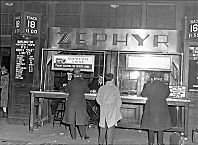|
"Zephyr" Ticket Counter, 1943

|
In 1855, the name of the Chicago & Aurora Railroad, which included several of the area's early rail lines, was changed to the Chicago, Burlington & Quincy. This road, which operated mainly in Illinois, Iowa, Missouri, and Nebraska, was a leading Chicago transportation line and local employer. In 1870, its car works in Aurora employed more than 1,200 men, making it the largest industrial employer in the Chicago region. As the company's rail network expanded, annual revenues rose to about $20 million by 1880. In 1901, the Chicago, Burlington & Quincy was purchased by James J. Hill, owner of the Northern Pacific and Great Northern railroads, based in St. Paul, Minnesota. By the early 1920s, the Burlington covered nearly 10,000 miles of road. Operating out of Union Station in Chicago, it became known as a technological pioneer in 1934, when it introduced the streamlined “Zephyr” high-speed diesel-electric passenger trains, and in 1950, when it ran air-conditioned, double-deck commuter cars out of Chicago. By the beginning of the 1960s, the road was collecting about $250 million in annual revenues and employed about 22,000 people nationwide. In 1970, the Burlington and the other lines in the old Hill empire finally merged, creating the Burlington Northern, which became the second-largest railroad system in the United States. In 1995, the Burlington Northern merged with the Atchison, Topeka & Santa Fe, forming the Burlington Northern Santa Fe, an even larger entity.
H. Roger GrantThis entry is part of the Encyclopedia's
Dictionary of Leading Chicago Businesses (1820-2000)
that was prepared by Mark R. Wilson, with additional contributions from Stephen R. Porter and Janice L. Reiff.
|
